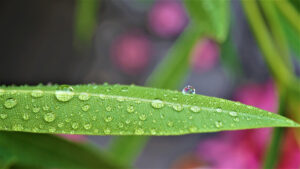
Newsbuds
Monitoring particulate matter with trees, shrubs and lichens
Cultural heritage in the form of historical buildings and their contents are heavily threatened by air pollution. Buildings surrounded by heavy traffic flows need constant monitoring to minimise the impact of exhaust gases and particulate matter on exposed surfaces. The International Centre for the Study of the preservation and Restoration of Cultural Property (ICCROM), with headquarters in Rome, promotes the approach of ‘preventative conservation aimed at avoiding and minimising future deterioration and loss.’ Ideally, protection should not interfere with the materials and structures, and not modify its appearance.
Between September 2020 and January 2021, a group led by Aldo Winkler from the National Institute of Geophysics and Volcanology used the magnetic properties of leaves and lichen to assess the impact of vehicular particulate matter (PM) on the Villa Farnesina, situated beside the Tiber River in the heart of Rome. The villa was built in the early 16th century and contains frescoes by Renaissance artists such as Raphael, and has high conservation value. Over time particulate matter accumulates on surfaces creating dark layers and discolouration.
Lichens, being independent from their supporting substrate can easily be taken from a remote site and exposed in a study area. The lichen in this case was used to monitor the air pollution from the outside of the building to the inside, including the influence of vehicle traffic and the magnitude of the deposition inside the building.
Initially the first sampling involved leaves collected from various rows of trees and shrubs aligned at increasing distances from the roadside. Leaves of Platanus sp. Cupressus sempervirens, Nerium oleander and Myrtus communis were sampled
Lichen Evernia prunastri from a pristine area around Sienna in Tuscany, Central Italy was collected, washed and placed in mesh bags. These bags were placed in strategic areas in rooms inside the villa as well as in the trees outside to gauge how distance from the road affected pollution levels. The samples were left for three months then tested using chemical and magnetic methods of analysis.
The leaves and lichen from a non-polluted area should have weak magnetic properties. The leaves and lichen exposed to the vehicular PM absorbed metals that come mostly from vehicle braking systems. Samples closest to the road had up to forty times the accumulated particulate matter than inside the villa but the tapering effect suggested the garden and trees were an effective filter. Although all plants absorbed pollution, some species absorbed more than others. Lichen was found to be an efficient and sensitive bio-monitor for particulate matter whereas the amount of pollution absorbed by the leaves of the trees was more variable. Trees however having a greater surface area accumulated much of the pollution generated by the road traffic.
‘Superworms’ process plastic waste

Researchers at the University of Queensland are worming their way toward environmentally friendly solutions for recycling plastic waste according to research published in Microbial Genomics.
A team led by Dr Chris Rinke from the university’s School of Chemistry and Molecular Biosciences, found that the common ‘superworm’ Zophobas morio can eat and digest polystyrene foam commonly used in packaging. The worms shred the plastic with their mouth and the bacteria in their gut break down the plastic compounds.
This research suggests processes using enzymes produced by bacteria in the gut of the superworm could be scaled up to industrial levels. A co-author of the research, PhD candidate Jiarui Sun, was quoted in the University of Queensland’s UQ News as saying they aim to grow the gut bacteria in the laboratory with a view to upscaling the process to a level required for an entire recycling plant. Dr Rinke pointed out that there are many opportunities for the biodegradation of plastic waste. The action of the bacterial enzymes on the plastic will produce usable chemical compounds suitable for re-use.
